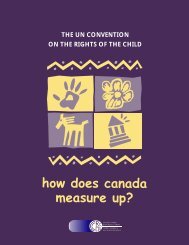CCRC report on rights of children in Canada - Canadian Coalition ...
CCRC report on rights of children in Canada - Canadian Coalition ...
CCRC report on rights of children in Canada - Canadian Coalition ...
Create successful ePaper yourself
Turn your PDF publications into a flip-book with our unique Google optimized e-Paper software.
ACTION<br />
Actors (Lead and Ma<strong>in</strong> Actors)<br />
Nati<strong>on</strong>al Child Income Security System<br />
Review “Safe School” legislati<strong>on</strong> and strategies,<br />
anti-bully<strong>in</strong>g programs, and protecti<strong>on</strong> laws <strong>in</strong> every<br />
prov<strong>in</strong>ce/territory to give priority to the best <strong>in</strong>terests<br />
<strong>of</strong> <strong>children</strong>, <strong>in</strong>clud<strong>in</strong>g c<strong>on</strong>siderati<strong>on</strong> <strong>of</strong> the views <strong>of</strong><br />
young people themselves.<br />
Provide regular tra<strong>in</strong><strong>in</strong>g for educators, school trustees<br />
and youth leaders <strong>in</strong> <strong>rights</strong>-respect<strong>in</strong>g behaviour<br />
management. Support educati<strong>on</strong> <strong>of</strong> <strong>children</strong> and<br />
youth <strong>on</strong> safe and legal use <strong>of</strong> digital technologies.<br />
Reduce violence aga<strong>in</strong>st <strong>children</strong> <strong>in</strong> sport through a<br />
nati<strong>on</strong>al strategy, us<strong>in</strong>g evidence-based educati<strong>on</strong>,<br />
regulati<strong>on</strong>, and c<strong>on</strong>sistent enforcement <strong>of</strong> legal<br />
protecti<strong>on</strong>s. The strategy should be <strong>in</strong>formed by<br />
research <strong>on</strong> the impacts <strong>of</strong> violence <strong>in</strong> sport <strong>on</strong> child<br />
survival, health, and optimal development.<br />
B CHILDREN’S RIGHT TO BE FREE FROM<br />
POVERTY<br />
Introducti<strong>on</strong><br />
Prov<strong>in</strong>cial/territorial departments<br />
resp<strong>on</strong>sible for <strong>children</strong><br />
Council <strong>of</strong> M<strong>in</strong>isters <strong>of</strong> Educati<strong>on</strong><br />
Prov<strong>in</strong>cial/territorial departments <strong>of</strong><br />
educati<strong>on</strong><br />
Council <strong>of</strong> M<strong>in</strong>isters <strong>of</strong> Prov<strong>in</strong>cial/<br />
territorial departments <strong>of</strong> educati<strong>on</strong><br />
Sport <strong>Canada</strong><br />
Departments resp<strong>on</strong>sible for recreati<strong>on</strong><br />
<strong>in</strong> prov<strong>in</strong>cial/territorial and municipal<br />
governments<br />
One <strong>in</strong> n<strong>in</strong>e <strong>children</strong> <strong>in</strong> <strong>Canada</strong> grows up without access to adequate resources for healthy<br />
development. 16 While the number <strong>of</strong> <strong>children</strong> liv<strong>in</strong>g <strong>in</strong> poverty is <strong>of</strong> great c<strong>on</strong>cern, so too is the depth<br />
<strong>of</strong> poverty. A majority <strong>of</strong> low-<strong>in</strong>come households with <strong>children</strong> live far below whatever measure is used<br />
as the poverty l<strong>in</strong>e. Us<strong>in</strong>g a multi-dimensi<strong>on</strong>al assessment <strong>of</strong> child poverty draws attenti<strong>on</strong> to important<br />
factors besides <strong>in</strong>come, such as poverty <strong>of</strong> time spent with parents. 17 Poverty dur<strong>in</strong>g childhood can do<br />
life-l<strong>on</strong>g harm. This has been documented <strong>in</strong> health research, <strong>in</strong>clud<strong>in</strong>g <strong>of</strong>ficial government <str<strong>on</strong>g>report</str<strong>on</strong>g>s cited<br />
<strong>in</strong> the secti<strong>on</strong> <strong>on</strong> health.<br />
<strong>Canada</strong> ranks well below other <strong>in</strong>dustrial countries <strong>in</strong> this area, plac<strong>in</strong>g 19th out <strong>of</strong> 26 <strong>in</strong> the most<br />
recent comparis<strong>on</strong> by the Organizati<strong>on</strong> for Ec<strong>on</strong>omic Cooperati<strong>on</strong> and Development (OECD). 18 Eleven<br />
countries <strong>in</strong> the same category as <strong>Canada</strong> have child poverty rates <strong>of</strong> less than 10%. Countries and<br />
prov<strong>in</strong>ces that have set targets and implemented specific strategies to reach those targets have made<br />
progress. <strong>Canada</strong>, by comparis<strong>on</strong>, has not made much progress s<strong>in</strong>ce 1989, when parliament passed a<br />
resoluti<strong>on</strong> to end child poverty by 2000.<br />
In 2008, the Nati<strong>on</strong>al Council <strong>of</strong> Welfare, an advisory group to the federal government, analyzed the<br />
impacts <strong>of</strong> the Nati<strong>on</strong>al Child Benefit System. This is the major government strategy to reduce child<br />
poverty. In 7 <strong>of</strong> 20 scenarios across the country, <strong>on</strong>e child with a l<strong>on</strong>e parent and two <strong>children</strong> with<br />
two parents <strong>in</strong> low-<strong>in</strong>come households were worse <strong>of</strong>f than 10 years before the Nati<strong>on</strong>al Child Benefit<br />
System was implemented. The council c<strong>on</strong>cluded that “the Nati<strong>on</strong>al Child Benefit System was a big<br />
step backwards <strong>in</strong> the fight aga<strong>in</strong>st child poverty.” 19<br />
In additi<strong>on</strong>, two changes made to <strong>in</strong>come support programs for <strong>children</strong> <strong>in</strong> 2006 and 2007 discrim<strong>in</strong>ate<br />
aga<strong>in</strong>st <strong>children</strong> <strong>in</strong> low-<strong>in</strong>come households. Under the current Universal Child Care Benefit program,<br />
some <strong>children</strong> <strong>in</strong> poor families receive less, after taxes, than <strong>children</strong> <strong>in</strong> wealthy families. Under the<br />
current Child Tax Credit, <strong>children</strong> <strong>in</strong> the poorest families receive no benefit compared to <strong>children</strong> <strong>in</strong><br />
affluent families who receive $300. The <strong>in</strong>troducti<strong>on</strong> <strong>of</strong> these policies happened at a time when 12.4%<br />
<strong>of</strong> <strong>children</strong> lived <strong>in</strong> poverty, and the wealthiest 10% <strong>of</strong> households with <strong>children</strong> had ten times the level<br />
<strong>of</strong> resources as the poorest 10%. In additi<strong>on</strong>, the child benefit program has become so complicated<br />
that many families do not know if they are be<strong>in</strong>g treated fairly or not. In 2010, a small correcti<strong>on</strong><br />
was made to provide more fair tax treatment for s<strong>in</strong>gle mothers compared to two-parent families,<br />
but the larger <strong>in</strong>equities between <strong>children</strong> were not addressed. The <str<strong>on</strong>g>CCRC</str<strong>on</strong>g> advocates for a fair and<br />
understandable system <strong>of</strong> support for families that ensures all <strong>children</strong> have the opportunity for a good<br />
start <strong>in</strong> life, as well as a nati<strong>on</strong>al poverty reducti<strong>on</strong> strategy.<br />
Ma<strong>in</strong>tenance Payments for Children<br />
Statistics <strong>Canada</strong> <str<strong>on</strong>g>report</str<strong>on</strong>g>ed that 64% <strong>of</strong> the cases <strong>in</strong> Ma<strong>in</strong>tenance Enforcement Programs across the<br />
country are <strong>in</strong> arrears. 20 Most <strong>of</strong> the 408,000 cases <strong>in</strong>volve <strong>children</strong>, who need the resources for<br />
immediate basic needs. More attenti<strong>on</strong> to enforc<strong>in</strong>g these agreements could help <strong>children</strong> at the time<br />
<strong>of</strong> life when they most need it.<br />
Recommendati<strong>on</strong>s<br />
ACTION<br />
Establish specific annual targets to reduce child poverty<br />
so that it is less than 5% by the 25th Anniversary <strong>of</strong> the<br />
C<strong>on</strong>venti<strong>on</strong> <strong>in</strong> 2014.<br />
Develop and implement a nati<strong>on</strong>al, coord<strong>in</strong>ated<br />
strategy to elim<strong>in</strong>ate child poverty, <strong>in</strong> the c<strong>on</strong>text<br />
<strong>of</strong> a broader nati<strong>on</strong>al poverty reducti<strong>on</strong> strategy.<br />
An effective strategy will <strong>in</strong>clude a comb<strong>in</strong>ati<strong>on</strong> <strong>of</strong><br />
measures, based <strong>on</strong> a multi-dimensi<strong>on</strong>al analysis <strong>of</strong> the<br />
c<strong>on</strong>diti<strong>on</strong>s necessary for healthy development.<br />
Actors (Lead and Ma<strong>in</strong> Actors)<br />
Human Resources and Skills<br />
Development <strong>Canada</strong><br />
Human Resources and Skills<br />
Development <strong>Canada</strong><br />
Parliament <strong>of</strong> <strong>Canada</strong><br />
32 Right <strong>in</strong> pr<strong>in</strong>ciple, right <strong>in</strong> practice Protect<strong>in</strong>g Children 33




